Workers were spotted carrying scaffolding into Mary Help of Christians Church last Friday, prompting concern among some neighbors as to whether there were any developments about the church’s future.
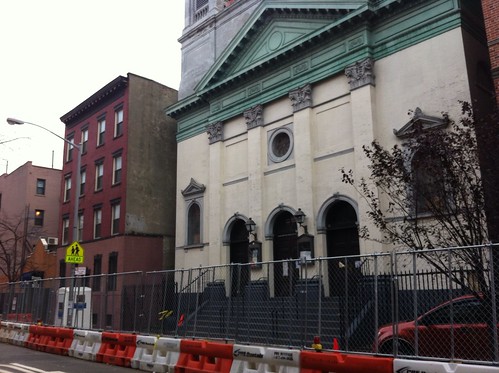 Suzanne Rozdeba
Suzanne RozdebaAround 3 p.m. late last week, “There was a huge Penske moving van and several workers in front of the church. The church doors were open,” an eyewitness told The Local. “I was concerned because we don’t know what’s going to happen with the church.” The church property was purchased by developer Douglas Steiner, who’s bringing a residential development to the lot between East 11th and 12th Streets.
“I saw the workers bringing in scaffolding into the church, and I thought, ‘Uh oh,’” said the eyewitness. “I asked one of the guys to please be careful with the remaining relics. I thought they were moving the rest of the stuff out. But he said, ‘We’re not taking anything out. We’re just putting up scaffolding in the church. It’s in rough shape. We’re putting up support for the church. It’s an old building.’” It was unclear whether there was work being done to the church’s interior, or whether it had anything to do with work being done at P.S. 60 next door.
Last month, The Local reported that preservationists would like to meet with Mr. Steiner to discuss the church’s future, and the possibility of preserving the church. Several neighborhood preservation groups, along with a neighbor and a former parishioner, have asked the Landmarks Preservation Commission to consider protecting the church. A source close to the project had said it was too early to know what the developer’s plans are for the site.
East Yoga Center, the vinyasa and pilates studio, has been looking for a permanent home since fire tore through its Avenue B premises last month.
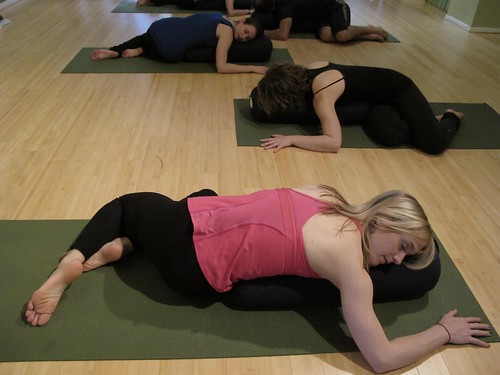 East Yoga Center
East Yoga Center Some good news came in the form of an email to supporters yesterday. The studio has raised $6500 in partnership with Lucky Ant, the crowdfunding site. Now comes the search for a permanent home. Meantime, the studio’s schedule reflects the availability of temporary locations.
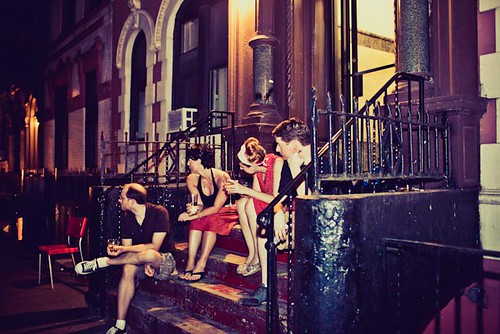 Entwined Studio The author, second from right, with friends on the stoop of 50 East Third Street.
Entwined Studio The author, second from right, with friends on the stoop of 50 East Third Street.A few weeks ago I had a night so magical it only could have happened in New York City: rooftop skyline, cocktails, killer jams. We were giddy. It was one of those nights that makes you want to dig out your old “I heart NY” t-shirt and wear it to bed.
The next morning, I got a buzz from the mailman. It was a registered letter from the landlord: we were getting evicted from our home at 50 East Third Street.
Our building sold and the new landlord had no interest in renewing our lease, so we were given 60 days to pack up our lives and vacate our apartments by May 14. Around 20 other people in our building and two neighboring ones at 54 and 58 East Third Street received the same notice. I was told that the sale of the building hinged upon the vacancy of our apartments. Our lives were used as a bartering chip.
The rug was literally being pulled from underneath us. Read more…
 Daniel Maurer Construction work on the building today.
Daniel Maurer Construction work on the building today.As recently as yesterday, Kathy Kirkpatrick was holding out hope that Life Cafe would be resurrected in spite of the “For Rent” sign in the window of her iconic restaurant and a simmering dispute between her two landlords (yes, she has two).
“I’m still waiting to see how it plays out,” Ms. Kirkpatrick said. “Things are getting resolved, things are developing — though meanwhile, I wait.”
But today the dispute boiled over and Bob Perl, one of her landlords, said Life Cafe was dead — he could no longer bear trying to negotiate with Abraham Noy, the other landlord.
“I can’t get it done,” Mr. Perl said. “I’m done with Noy – these guys are just impossible.” Read more…
Photos: Paul Wagtouicz
Since the Amato Opera closed in 2009, it has been one of the more notable vacant buildings on the Bowery. The opera’s founder died yesterday of cancer, and the building is still empty and on the market for $6.5 million.
The broker of the building at 319 Bowery, Lauren Muss, said she planned to show the property twice today. “It’s definitely interesting to people, it’s just about a price,” Ms. Muss said. “They make offers, then they disappear.” Read more…
Two adjacent lots on East Houston Street near Attorney Street have recently gone on the market for $9.5 million, The Lo-Down reports. The lots, at 327-329 East Houston Street, are part of the portfolio of the deceased William Gottleib, who was “legendary for hoarding his estimated $1 billion worth of NYC properties,” according to the blog. Following an inter-family struggle, Mr. Gottleib’s nephew is now selling much of the real estate empire piece by piece.
 Stephen Rex Brown The Cabrini Center at 542 East Fifth Street.
Stephen Rex Brown The Cabrini Center at 542 East Fifth Street.The six-story building that houses a medical center catering to the elderly is on the market, raising concerns that a new landlord will give low-income patients the boot before the center can build a new location.
Last night, Community Board 3 sounded the alarm on the possible closure of the Cabrini Center for Nursing and Rehabilitation, sending a formal letter to the lawyer of the mystery buyer of the building at Avenue B and Fifth Street. Read more…
While the Greenwich Village Society for Historic Preservation mourns the loss of 331 East Sixth Street (the fourth pre-Civil War building in the East Village to be demolished this year, the GVSHP’s site points out), Curbed learns that two nineteenth-century townhouses on East 10th Street are now being marketed as a pair for $12.5 million (down from $17.8 million three years ago).
 Michelle Rick
Michelle RickIf you don’t live here in the East Village, you all naturally assume that we collectively get up around 10:30 a.m., rearrange our dreadlocks, drink coffee while sitting on a fire escape, admire the worn painted ads on the sides of our buildings, and then begin our long day of dance auditions before our bartending gigs start at 5 p.m.
You imagine that our clothes are beautifully tie-dyed and that our jewelry looks like we sprinkled a Tibetan souvenir shop onto ourselves. You picture us writing poetry on a bed of leaves in Tompkins Square Park, only raising our heads to drink wheatgrass smoothies. You are not wrong about any of this, and we are ALL like this.
However, it has recently come to my attention that real estate in the East Village is incredibly expensive.
Expensive to the point where if a group of roommates were to live in a two-bedroom apartment overlooking Pommes Frites and live the lifestyle described above, said group would need to be about 10 people to afford this kind of East Village abode, and that is not including the upkeep of dreads.
Read more…
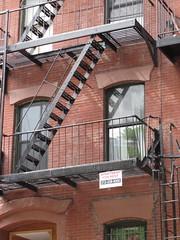 Meghan Keneally One of the few available rentals.
Meghan Keneally One of the few available rentals.When scouring apartment listings, it always seems like that time — that particular time when you decided to move — was the worst possible choice because there are so few apartments available. For those searching now, they’re not just imagining it.
The percentage of available apartments in Manhattan this May hit its lowest rate in the past five years. With every neighborhood differing slightly, the East Village average was 0.69 percent — the same as the city wide average — and the overall city vacancy rate decreasing by 0.25 percent from the month prior.
According to StreetEasy, a real estate comparison website, the overall amount of rental apartments in Manhattan is down by 18 percent from this time last year.
“Rental inventory is tight everywhere right now. It’s the season: May, June, and July are the peak months for rental,” said Sofia Song, vice president of research at StreetEasy.
The East Village is known largely in the real estate world for being filled with college students and recent grads (along with the artists and musicians who shaped the area’s identity), and while they do still make up a sizable amount of the market, there are other groups interested in the area.
Read more…
 Mark Riffee Anne Guiney.
Mark Riffee Anne Guiney.It would be a gross understatement to say that the East Village is in the midst of a transition. Old buildings have been threatened and new ones are scheduled to rise, much to the chagrin of many locals. But as Bill Millard, an East Village resident and freelance writer for various architectural and urban design publications, points out in an e-mail, it’s just as “important to consider ways to encourage the types of development that provide or foster benefits for a neighborhood” as it is to protest and block “destructive forms of development.”
So what kind of development is positive and why, recently, have some seemingly less favorable projects been allowed to continue in the East Village? The Local caught up with Anne Guiney, executive director of the Institute for Urban Design, and asked for her thoughts.
Q.
What architectural elements characterized the East Village before the gentrification of the neighborhood?
A.
It all depends on what your carbon dating system is for gentrification and how you define it. I think the East Village has, for a very long time, been defined by tenements in terms of building type. And that hasn’t changed a lot architecturally. Obviously the street-level retail and the kinds of uses are a lot more commercial, a lot more recreational than they were 20 or 30 years ago, but the physical structure of the buildings is still defined by the tenement.
Read more…
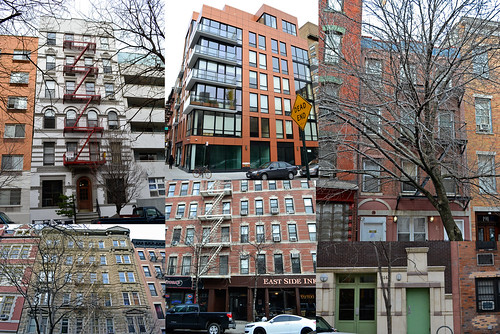 Photo illustration by Mark Riffee Six buildings with apartments for sale in the East Village.
Photo illustration by Mark Riffee Six buildings with apartments for sale in the East Village.It’s fun to gawk at the $3 million lofts and $4 million townhouses in Curbed’s Marketplacelistings for the East Village. Most of us can’t do much more than gawk at these palatial 3,500-square-footers unless we’re feeling very ambitious and chance a pipe dream while lying in our beds — which are conveniently five steps from the kitchen, bath, and front door in our 450-square-foot studios — wondering if today is a hot-water day or no-hot-water day.
But maybe someday we will be able to afford a less garish apartment with a more reasonable price tag. In fact, if you have the money now or in the next few years, you may want to think about making a move sooner than later. According to Tara-Nicholle Nelson, consumer educator for Trulia.com, a real estate search engine company and research group, prices and interest rates are extremely low right now and qualifying for loans will become more difficult in coming years.
We at The Local asked Ms. Nelson for a status update on the East Village market and some expert advice on buying and selling.
Q.
How has the East Village market evolved recently?
A.
In terms of price, we’ve seen value increase over this past year. On a price per square footage basis, there’s been a 26.5 percent year-over-year increase to $1,087 per square foot from $798 per square foot.
Read more…
The entry of 2 Cooper Square onto the East Village real estate scene has been well-chronicled, from its high-profile residents to the renovation of the landmarked Skidmore House next door.
Recently, The Local spoke with residents of the luxury high-rise about life in one of the neighborhood’s newest – and priciest – addresses, which has a gym and screening room in the basement lounge as well as a much blogged-about rooftop pool.
Residents say the building’s amenities are top-notch. For some, though, the prime East Village location is perhaps busier than they had expected. One resident cites disturbances from an ongoing construction project on Fourth Street, which impacts residents in Southern-facing units; she also says that noise from the nearby nightspot Bowery Bar keeps her up at night.
NYU Journalism’s Stephanie Butnick reports.
Comprehensive real estate information about the East Village is available at the following links:
 Stephanie Butnick The buildings at 9, and 11-17 Second Avenue, which will be renovated as part a new development featuring low-income apartments that would be available for as little as $1.
Stephanie Butnick The buildings at 9, and 11-17 Second Avenue, which will be renovated as part a new development featuring low-income apartments that would be available for as little as $1.Developers are expected to seek Community Board approval Wednesday for a plan to renovate a row of properties along Second Avenue, and sell some of the apartments to low-income families for as little as $1.
The mostly low-income families who currently live in the two buildings at 9 and 11-17 Second Avenue are guaranteed units in the proposed development, which would combine the two structures into one larger building.
The project, run by development firm BFC Partners, is operating under the Department of City Planning’s 2009 amendment to the inclusionary housing program, which creates permanently affordable housing, now with the option to buy. According to Juan Barahona of the development firm, tenants will be able to buy the new apartments for between $1 and $10.
The project will also take advantage of new zoning laws that allow developers to build more square footage on a lot, provided they allocate 20 percent of the building’s total area to affordable housing.
In this case, the 12-story, 4,000 sq. ft. building will house approximately 12 low-income units (available to those making 80 percent or less of the area’s median income ̶ approximately $63,000), dispersed throughout the complex, and about 48 market rate units. The development’s market-rate units, which make up the majority of the building, will offset costs.
Read more…
 Darla Murray This holiday season may be the last in which some New Yorkers are able to offer their apartments for short-term stays because of new regulations governing sublets.
Darla Murray This holiday season may be the last in which some New Yorkers are able to offer their apartments for short-term stays because of new regulations governing sublets.As the holiday season approaches, Web sites like Roomorama, Homeaway and Craigslist will be flush with temporary vacation rental listings. According to Jia En, founder of Roomorama, a company specializing in short-term rentals, East Villagers are among the most active users of vacation rental sites.
“People in this neighborhood tend to travel a lot,” says Ms. En, who adds that they are also business savvy because “instead of leaving their place empty, they use it as a way to earn some extra money.” The holiday season can be especially lucrative.
“New Year’s Eve is one of the most popular times for visitors,” says Ms. En.
Unfortunately, for both residents wanting to make some extra cash and tourists hoping to save some, this will be the last holiday season that tenants will be able to sublet their apartments for short stays. In July, Governor David A. Paterson signed into law a bill that makes it illegal to rent out apartments for less than 30 days in New York.
The Local consulted veteran East Village subletters to draft a list of the Dos and Don’ts of subletting, just in case you’re hoping to take advantage of your last holiday season of short-term leasing:
Read more…
 This image from NYU’s 2031 expansion plan depicts a proposed tower near Houston and Mercer Streets. It is still unclear how the plan will affect the East Village.
This image from NYU’s 2031 expansion plan depicts a proposed tower near Houston and Mercer Streets. It is still unclear how the plan will affect the East Village.New York University’s so-called “2031 plan” for expansion contains detailed proposals for what it calls its “Core” around Washington Square. What concerns many East Village residents is a larger boundary that the university has drawn around the Core.
University officials call it “the Neighborhood,” and on maps published about the expansion plan it clearly contains the East Village. The Neighborhood figures in the university’s long-term plans, but the specifics remain unknown.
“We can’t live in a world where everything is no, no, no.” That’s New York University spokeswoman Alicia Hurley’s reaction to the welcome she received from the East Village’s Community Board 3.
“We have heard you, and we’re very conscious of your concerns. Our most recent dorm purchase was at 23rd and Third, well outside the Neighborhood.” But in response to discussions with East Village residents she says, “Help us to understand which areas are most sensitive. Are there sites which are under-performing. Are certain types of use acceptable?”
She wonders whether an extension of the Tisch School of the Arts would be welcome in the area. “If you want to just say no, and be afraid, there’s not much I can do. We’re happy for you to coach us.”
Read more…
 Sarah Tung
Sarah TungWe wanted to bring your attention to four features here on the site that we think can help you learn more about what’s happening in our community.
To find the first, just look up. There, on the blue bar at the top of the page, is a new heading “News River.” It opens directly onto an aggregator of links from the East Village blogosphere that was developed by Dave Winer, a visiting scholar at NYU Journalism.
We briefly mentioned a second addition earlier this week: a series of links that provide comprehensive real estate data about the East Village. You can find them if you scroll down the column along the right side of this page or by following these links.
And directly below the real estate links in the right column is a special pull-down menu that provides test score information about public elementary and high schools that serve the East Village.
Below the schools data is the final feature that we’d like to bring to your attention: our pull-down menu of East Village restaurants drawn from data at The Times.
These are just a few more of the collaborative ways that we’re bringing value to the blogosphere through the talents of Mr. Winer and our colleagues at The Times.
















